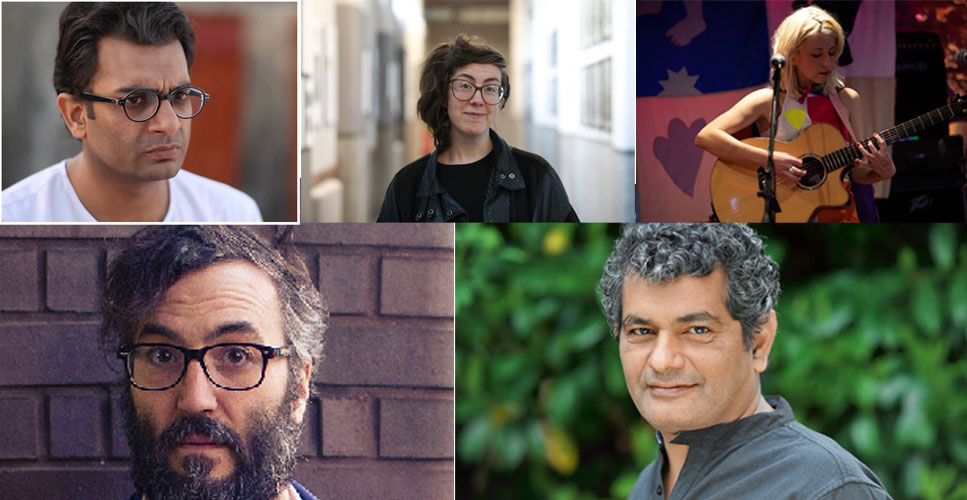Written by: Farheen Abdullah
Posted on: October 12, 2020 | 
Poster for 'Before the Sun Comes Up'
To commemorate the 18th World Day Against the Death Penalty on October 10, Justice Project Pakistan (JPP) collaborated with Dawn.com, Golden Hour Productions and Mishermayl Productions to produce a live art performance titled, ‘Before the Sun Comes Up’. The virtual event featured four short stories by noted Pakistani writer Muhammed Hanif, who traces the story of four individual prisoners awaiting their execution in an attempt to highlight the flaws of the justice system and the issue of wrongful executions.
Narrated by Sarmad Khoosat, the stories were divided thematically, and were based on real execution cases: ‘The Ready-Made Killer’ focuses on intention, ‘The Prisoner Who Did Something’ on giving and earning respect, ‘The Man Who Had One Job’ talks about employment and ‘The Lucky Woman’ is about forgiveness. Each chapter spoke of the circumstances that brought the unlucky prisoners to death row, and how they had been manipulated by powerful people to face a fate that was never theirs.
Explaining his motivations to write stories of failed justice, Hanif elaborated, “I have been thinking of Ghulam Qadir and Ghulam Sarwar who were accused of murder and then sentenced to death. Finally, they were acquitted by the Supreme Court. Only they had been hanged a year earlier. It should make us all reflect on our collective desire to hang people summarily. Do we want justice or do we want a spectacle and a distraction?”
As for Khoosat, this is not the first time he has collaborated with JPP: he has also previously performed a 24-hour-long live act titled, ‘No Time To Sleep’, enacting the last 24 hours of a death row prisoner’s life. However, this time, he collaborated with Creative Director Ryan Van Winkle, Emma Brierly, a Scottish multi-disciplinary artist who provided the surrealist puppetry visuals for the latest performance, and Hailey Beavis, who was in charge of the tense, anticipatory music.

(L to R, row-1) Sarmad Khoosat, Emma Brierley, Hailey Beavis and (row 2) Ryan Van Winkle, Mohammed Hanif
The teasers of ‘Before the Sun comes up’ were instantly gripping. Displaying words and animations on an otherwise dark screen that moved along to Khoosat’s voice in the background, the teasers were short but brilliantly conveyed the sense of urgency and loss of time that a prisoner faces. The opening lines of the trailer were also how the virtual event began, Khoosat’s voice echoing in the ears of his listeners. “You think you are in a lockdown? Are you in a lockdown? We are too,” immediately inculcated a sense of guilt in the viewers as we watched the event from the comforts of our screens, feeling suffocated in safe spaces as we continue to live through a pandemic. The narrative was a wakeup call for those of us who feel like we have been trapped inside our homes without any warning and without knowing when it will be over. The prisoners in Hanif’s story, however, know how their story is going to end, and how it is not going to be a good one.
Hanif takes audiences through the different stories in his signature dark humor, morally complex characters and sharp writing. Each performance delved into the prisoner’s thought process as they awaited their unjust fate, as they challenged and questioned an unfair system that cherishes violence over implementing justice. Although the characters come from different backgrounds, and react differently to the news of their executions, they suffer in similar ways at the hands of an increasingly intolerant society.
As the viewer who sits at home, we cannot help but surrender ourselves to the frustration, claustrophobia and fear of the prisoners. These feelings of dread were altogether accentuated through the help of the grim and surreal puppetry, and the frozen faces of the accused as they narrate their tales.
Unfortunately, while the performance did leave a disclaimer that the mistakes made during the performances were intentional, due to the unedited nature of the performance, the live performance itself may not have been able to match the sense of urgency and panic that was initially implied. The four stories were spaced out over more than an hour, with long intervals between each chapter, which meant that Khoosat’s voice lost its initial gusto from time to time. The use of four screens to narrate the story often became a little confusing to follow; due to difficulties in internet connections, some screens remained still for too long, which proved somewhat distracting for people looking for visual cues from the screen.
Keeping the audience engaged over a virtual event is not an easy task, and the viewer is likely to get distracted unless their attention is maintained by stunning visuals or a gripping narrative. However, technical issues aside, JPP has managed to create a collaboration that can be seen as a gripping visual performance of how justice can be fleeting, especially for the vulnerable. It complicates the conversation around the death penalty by bringing to life the stories and emotions of those who are wrongfully sentenced, and rarely live long enough to hope for justice to be implemented for them.
You may also like: